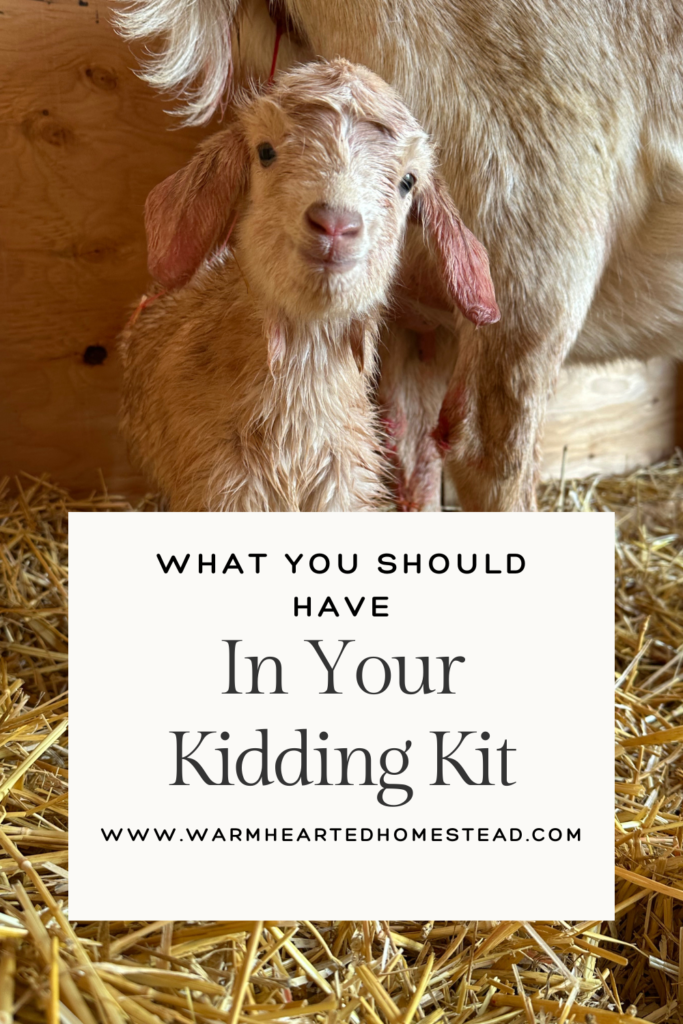With kidding right around the corner here at RRRR Farm, we are preparing our kidding kit.
When preparing your kidding kit, you are preparing for less than ideal scenarios. In a perfect world, your does will all kid out unassisted and clean of their babies perfectly. But things don’t always go perfectly. If you are a newer goat owner, check out our guide for beginners!
****Disclaimer: The information provided on this website is for general educational purposes only and does not constitute veterinary advice. Always consult with a licensed veterinarian regarding any health concerns your pet may have. Do not disregard professional medical advice or delay seeking treatment based on information found here. In case of an emergency, contact your veterinarian or an emergency animal clinic immediately****
Goat Gestation: When will your goat’s have kids?
A goat gestation is approximately 5 months. Or, 145 days for miniature breeds (Nigerian Dwarf, Pygmy) or 150 days for standard breeds (Nubian, New Zealand Kiko, Saanen, etc).
Rather than counting days on my calendar, I like to used the American Goat Society’s Goat Gestation Calculator. If you have an idea of when the buck was in with the does, you will be able to calculate a due day.

My Kidding Kit List
- Injectable Selenium with Vitamin E
- if you live in a selenium deficient area (selenium is found in the soil) your animals could be at risk for White Muscle Disease
- I inject all my kids within 24 hours of being born.
- Antiseptic solution for umbilical cord
- iodine or betadine
- spraying/ dipping the navel/ umbilical cord can help prevent infections
- Spray bottles or Dixie cups work great for spraying ot dipping
- Needles
- 18 gauge, 20 gauge and 22 gauge
- The smaller the number the LARGER the needle.
- Syringes
- 1ml, 3ml, 6ml
- I prefer luerlock syringes
- Bulb syringe
- Old, clean towels
- Hair Dryer
- To dry off and warm kids quickly. Essential in cold weather kiddings.
- Exam gloves
- Lubricant
- Small feeding tube with syringe
- Bottle and nipple (Pritchard Teat Nipple fits onto any pop bottle)
- Digital thermometer
- This is for rectal use, clean between uses****
- Colostrum Replacer
- Hanging scale and cloth shopping bag to get newborn weights
- Ear tagger and small ear tags
- Paper Towels
- Dental floss
- incase you need to tie of an umbilical cord
- Clean scissors
- for trimming long umbilical cords
- Molasses
- Mix with warm water for mom’s after kidding
- Electrolytes
- to mix with the molasses and warm water
- Stethoscope
- Not only for kidding. Great to have on hand for any livestock.
- Practice listening to your animals heart, lungs and gut sounds when they are healthy. This will help you hear unhealthy sounds easier.
- OB Tape
- a soft, flat, non adhesive tape, used for makeshift snares to hang onto legs if you need to assist in kidding.
Post-Kidding
After kidding, it is ESSENTIAL that the kids are up and nursing soon. I like to see my kids trying to nurse within one hour. Your kids need colostrum for their survival.
What is Colostrum?
Colostrum is the first milk produced by a goat after giving birth. It’s thick and yellowish, and contains antibodies, vitamins, minerals, and fat. Colostrum is essential for newborn goats because it helps them develop a strong immune system.
Why is Colostrum Important?
- Antibodies: Colostrum contains antibodies that protect newborn goats from disease. These antibodies provide passive immunity for the first two months of life.
- Energy: Colostrum provides the energy needed to stay warm.
- Laxative: Colostrum acts as a laxative to help newborn goats pass meconium.
How much colostrum should a newborn goat get?
- Newborn goats should ingest 10% of their body weight in colostrum within the first 12 to 24 hours of life.
- At least half of this volume should be consumed within 4 to 8 hours after birth.
What if your doe does not have colostrum?
If you notice that your doe does not have any colostrum, you can buy powdered colostrum at your local vet clinic, livestock supply or feed store. Bovine colostrum will work but you will require a larger volume of it. Powdered colostrum is essential in your kidding kit.
The Doe, Post-Kidding
After my doe kids, I sit back and watch to make sure she is taking care of her kids. That means she is vocalizing to them, licking them and encouraging them to get up and nurse.
She is offered a bucket of warm water, molasses and electrolytes from your kidding kit. The doe will have access to fresh water and hay. Once her and the kids are settled, I will offer her grain.
I check her teats and express a few drops of colostrum to make sure none of her teats are plugged.
Placenta or Afterbirth Post-Kidding
Ideally, your doe will pass her placenta within 6 hours. It can take longer. If the placenta is not passed within 12 to 18 hours, it is considered retained. A retained placenta, you should call your veterinarian for guidance.

Leave a Reply